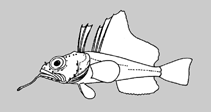Pogonophryne maculiventrata Spodareva & Balushkin, 2014
Upload your photos and videos
Pictures | Google imageNo image available for this species;
drawing shows typical species in Artedidraconidae.
Pictures | Google imageNo image available for this species;
drawing shows typical species in Artedidraconidae.
Common names from other countries
Classification / Names Common names | Synonyms | Catalog of Fishes(genus, species) | ITIS | CoL | WoRMS | Cloffa
Teleostei (teleosts) > Perciformes/Notothenioidei (Icefishes) > Artedidraconidae (Barbled plunderfishes)
Etymology: Pogonophryne: Greek, pogon = beard + Greek, phrynos = toad (Ref. 45335); maculiventrata: Name from Latin words 'macula' for spot and 'venter' for belly; referring to its spotted belly.
Etymology: Pogonophryne: Greek, pogon = beard + Greek, phrynos = toad (Ref. 45335); maculiventrata: Name from Latin words 'macula' for spot and 'venter' for belly; referring to its spotted belly.
Environment: milieu / climate zone / depth range / distribution range Ecology
Marine; demersal; depth range ? - 360 m (Ref. 96821). Polar
Distribution Countries | FAO areas | Ecosystems | Occurrences | Point map | Introductions | Faunafri
Antarctic Atlantic: Antarctica, Bransfield Strait.
Size / Weight / Age
Maturity: Lm ? range ? - ? cm
Max length : 16.4 cm SL (female)
Max length : 16.4 cm SL (female)
Short description Identification keys | Morphology | Morphometrics
Dorsal soft rays (total): 30; Anal soft rays: 17; Vertebrae: 38. This species belongs to the 'marmorata' group of the genus Pogonophryne is distinguished by the following characters: spotted thorax and belly; unusual caudal fin colouration with central area divided into 2 parts by light transverse streak, upper proximal and smaller distal parts, and upper edge and tips of rays at the bottom of caudal fin light; esca bearing no cylinder like folds in the form of cerebral surface, well-developed post temporal ridges, mental barbel equals 25.5% of HL, length of esca 48.3% TL of the length of barbel (Ref. 96821).
The female specimen collected has eggs in the ovaries which have reached 1.2 mm in diameter (Ref. 96821).
Life cycle and mating behavior Maturity | Reproduction | Spawning | Eggs | Fecundity | Larvae
Main reference
Upload your references | References | Coordinator | Collaborators
Spodareva, V.V. and A.V. Balushkin, 2014. Description of a new species of plunderfish of genus Pogonophryne (Perciformes: Artedidraconidae) from the Bransfield Strait (Antarctica) wit a key for the identification of species of the group "marmorata". J. Ichthyol. 54(1):1-6. (Ref. 96821)
Threat to humans
Harmless
Human uses
FAO(Publication : search) | FishSource |
More information
Trophic ecology
Food items
Diet composition
Food consumption
Food rations
Predators
Food items
Diet composition
Food consumption
Food rations
Predators
Ecology
Ecology
Home ranges
Ecology
Home ranges
Population dynamics
Growth parameters
Max. ages / sizes
Length-weight rel.
Length-length rel.
Length-frequencies
Mass conversion
Recruitment
Abundance
Growth parameters
Max. ages / sizes
Length-weight rel.
Length-length rel.
Length-frequencies
Mass conversion
Recruitment
Abundance
Life cycle
Reproduction
Maturity
Fecundity
Spawning
Spawning aggregations
Eggs
Egg development
Larvae
Larval dynamics
Reproduction
Maturity
Fecundity
Spawning
Spawning aggregations
Eggs
Egg development
Larvae
Larval dynamics
Anatomy
Gill area
Brain
Otolith
Gill area
Brain
Otolith
Physiology
Body composition
Nutrients
Oxygen consumption
Swimming type
Swimming speed
Visual pigments
Fish sound
Diseases & Parasites
Toxicity (LC50s)
Body composition
Nutrients
Oxygen consumption
Swimming type
Swimming speed
Visual pigments
Fish sound
Diseases & Parasites
Toxicity (LC50s)
Genetics
Genetics
Heterozygosity
Heritability
Genetics
Heterozygosity
Heritability
Human related
Aquaculture systems
Aquaculture profiles
Strains
Ciguatera cases
Stamps, coins, misc.
Aquaculture systems
Aquaculture profiles
Strains
Ciguatera cases
Stamps, coins, misc.
Tools
E-book | Field guide | Length-frequency wizard | Life-history tool | Point map | Classification Tree
| Catch-MSY |
Special reports
Download XML
Internet sources
Aquatic Commons | BHL | Cloffa | Websites from users | Check FishWatcher | CISTI | Catalog of Fishes(genus, species) | DiscoverLife | ECOTOX | Faunafri | Fishtrace | GenBank(genome, nucleotide) | GloBI | GOBASE | | Google Books | Google Scholar | Google | IGFA World Record | MitoFish | Otolith Atlas of Taiwan Fishes | PubMed | Reef Life Survey | Scirus | SeaLifeBase | Tree of Life | Wikipedia(Go, Search) | World Records Freshwater Fishing | Zoobank | Zoological Record
Estimates based on models
Phylogenetic diversity index (Ref. 82804): PD50 = No PD50 data [Uniqueness, from 0.5 = low to 2.0 = high].
Bayesian length-weight: a=0.00501 (0.00240 - 0.01046), b=3.13 (2.94 - 3.32), in cm Total Length, based on LWR estimates for this (Sub)family-body shape (Ref. 93245).
Trophic level (Ref. 69278): 3.3 ±0.5 se; based on size and trophs of closest relatives
Fishing Vulnerability (Ref. 59153): Low vulnerability (10 of 100).




